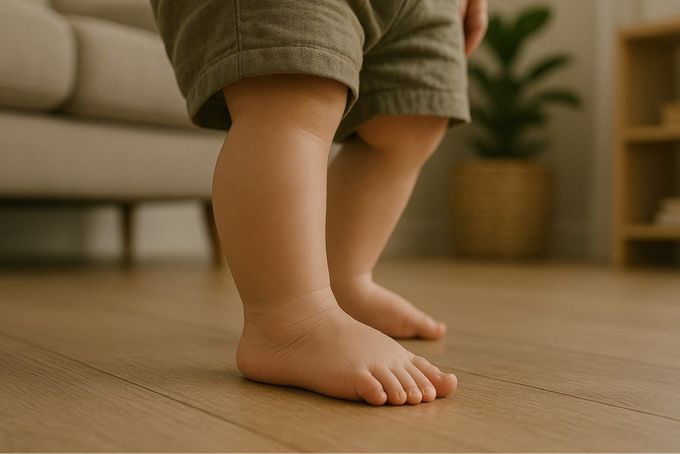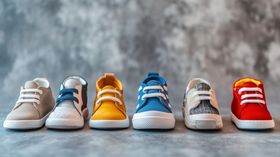When Do Toddlers Develop Arches in Their Feet?
All babies are born with flat feet due to fat pads and flexible joints, which is completely normal. Most children develop foot arches between the ages 2-10, with the arches of the foot fully developed by age 10 in the majority of kids.
Published July 8, 2025

You watch your toddler toddle across the living room and notice something strange. Their feet look completely flat. No arch in sight. You start wondering if something's wrong with their development.
You're not alone. Most moms worry when they see their child's pancake-flat feet. The good news? Those flat feet are exactly what nature intended.
Why Your Baby's Feet Look Flat
Your baby was born with flat feet for good reason. It's a normal foot development milestone your little one will go through. A thick fat pad sits in the center of their foot sole, making the arch disappear [1]. Their foot joints are also very flexible, creating that pancake-flat appearance.
This design supports a toddler's balance and coordination development while they're learning to walk.
When Do Arches Form in Children’s Feet?
Pediatric foot arch formation is typically complete by age 10 in most children, though some babies develop foot arches as early as age 2. [2]
Walking itself helps create the arch. Each step strengthens foot muscles and tightens the ligaments holding foot bones together. As your kid grows, the fat pad thins out and muscles get stronger, forming a familiar curved shape.
Why Some Kids Stay Flat-Footed
About 60% of kids aged 2-6 have flat feet, which is completely normal as arches form in children's feet gradually [2]. By ages 8-13, only 20% still have them, showing how foot arches develop naturally over time [2].
Genetics plays a big role. If you have flat feet, your child probably will too. Weight also matters; heavier kids put more pressure on their feet' middle section, keeping arches from forming [3].
Wearing shoes too early might prevent proper arch development [4]. Barefoot walking benefits toddlers, helping them build stronger foot muscles.
Why One Foot Might Look Different
Don't panic if one foot appears flatter than the other. This happens often, especially in the non-dominant foot. Right-handed kids typically have flatter left feet due to walking mechanics [5].
Red Flags That Need Attention
Most flat-footed kids feel fine. But watch for these warning signs:
- Foot or leg pain during sports
- Getting tired quickly while walking
- Ankle or knee pain after running
- Limping or refusing to put weight on the feet
If you notice any of these signs, take your little one to a podiatrist to rule out any underlying conditions.
Supporting Healthy Foot Development
You can support healthy foot development in your child by encouraging barefoot time at home and incorporating simple toddler foot exercises and strengthening activities. When shoes are necessary, choose orthopedic options with built-in arch support, such as First Walkers.
If your child shows pain or unusual walking patterns, consult your pediatrician. Remember, foot arch development varies by child, so patience is key. Most babies develop foot arches between the ages of 2-10, and the arches of the foot are fully developed by age 10 in the majority of children.
References:
- Y. Ueki, E. Sakuma, and I. Wada, “Pathology and management of flexible flat foot in children,” Journal of Orthopaedic Science, vol. 24, no. 1, pp. 9–13, Oct. 2018, doi: 10.1016/j.jos.2018.09.018. Available: https://pubmed.ncbi.nlm.nih.gov/30366675/
- “Which Foot is at Risk? Understanding the Evolution of the Pediatric Flatfoot.” Available: https://www.jfasap.com/abstractArticleContentBrowse/JFASAP/32029/JPJ/fullText
- S. Górna, K. Pazdro-Zastawny, A. Basiak-Rasała, M. Kolator, J. Krajewska, and T. Zatoński, “Characteristics of paediatric foot arches according to body mass among primary school students in Wrocław, Poland,” BMC Pediatrics, vol. 22, no. 1, Nov. 2022, doi: 10.1186/s12887-022-03699-z. Available: https://pmc.ncbi.nlm.nih.gov/articles/PMC9648018/
- Y. Wang et al., “Understanding the role of children’s footwear on children’s feet and GAIT Development: A Systematic scoping review,” Healthcare, vol. 11, no. 10, p. 1418, May 2023, doi: 10.3390/healthcare11101418. Available: https://pmc.ncbi.nlm.nih.gov/articles/PMC10218108/
- H. Hadoush, Z. Qabook, S. F. Kanan, and N. A. Almasri, “Foot arch asymmetry and its correlations with physical fitness level and body mass index among school-aged children,” Journal of Bodywork and Movement Therapies, vol. 42, pp. 424–430, Jan. 2025, doi: 10.1016/j.jbmt.2025.01.004. Available: https://pubmed.ncbi.nlm.nih.gov/40325702/
Disclaimer: First Walkers' information is intended for educational and informational purposes related to toddler footwear and feet. We encourage you to consider individual circumstances and consult qualified orthopaedists about specific conditions.
FAQs
Is it normal for a 2-year-old to have flat feet?
Yes, it’s normal. Most toddlers have flat feet due to undeveloped arches and baby fat in the feet.
What should a 2-year-old's feet look like?
They typically appear flat, chubby, and soft, with arches that are not yet visible.
Is arch height genetic?
Yes, arch height is largely influenced by genetics, though muscle tone and activity also play a role.
How do I know if my child needs orthotics?
If your child has pain, frequent tripping, difficulty walking, or poor posture, a podiatrist may recommend orthotics.
Is flat foot linked to autism?
Flat feet are more common in children with autism due to low muscle tone, but flat feet alone are not a sign of autism.
How do doctors test for flat feet?
They perform a physical exam, check foot alignment during standing and walking, and may use imaging like X-rays if needed.
Related Articles

How to Feed Your Toddler Healthy Food
First Walkers
June 10, 2025

Best Infant Ankle Boots of 2026: 9 Picks for Cozy Feet
Jasrah Javed
December 6, 2024

Orthopaedic Shoes for Toddlers: Challenges & Benefits
Caitlin Snethlage
November 30, 2024

7 Types of Shoes Every Toddler Should Have: Guide for Parents
Chibuye Kunda
April 28, 2025

When Do Babies Start Wearing Shoes? What Experts Say
Chibuye Kunda
October 24, 2025